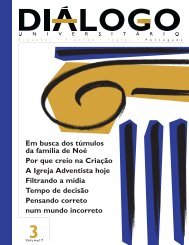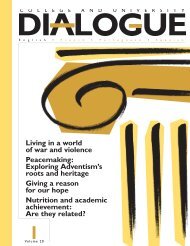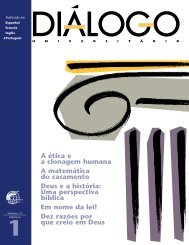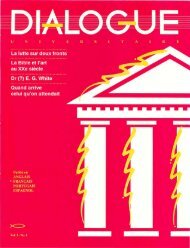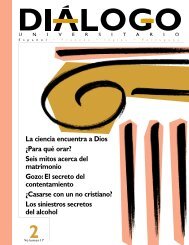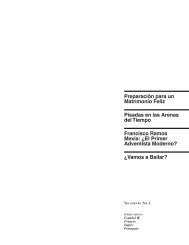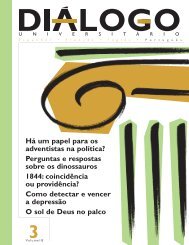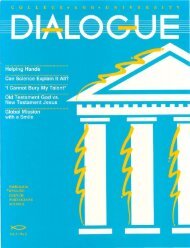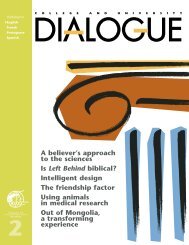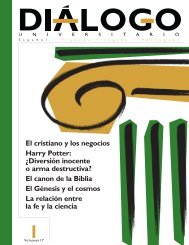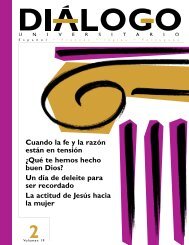Faith, reason, and the educated Christian Creationism - College and ...
Faith, reason, and the educated Christian Creationism - College and ...
Faith, reason, and the educated Christian Creationism - College and ...
You also want an ePaper? Increase the reach of your titles
YUMPU automatically turns print PDFs into web optimized ePapers that Google loves.
ours is a capricious world, subject<br />
to <strong>the</strong> whims of supernatural powers.<br />
Science is not equipped to<br />
study such a world.<br />
c. <strong>Creationism</strong> restricts <strong>the</strong> range of<br />
inquiries, because by definition,<br />
<strong>the</strong>re is no point studying <strong>the</strong> origins<br />
of life or <strong>the</strong> relationships between<br />
organisms.<br />
d. <strong>Creationism</strong> implies accountability.<br />
Then humankind is not <strong>the</strong> supreme<br />
authority in <strong>the</strong> world.<br />
Responses to <strong>the</strong>se observations:<br />
a. The fact that a creation story exists<br />
in different ancient cultures<br />
suggests a common source for<br />
<strong>the</strong>se stories.<br />
b. The Supreme Being of <strong>the</strong> Bible<br />
created a world with laws that<br />
were ei<strong>the</strong>r given or which can be<br />
discovered. Humans are m<strong>and</strong>ated<br />
to subdue <strong>and</strong> care for creation,<br />
using <strong>the</strong>se laws. There appears to<br />
be no caprice in <strong>the</strong> routine operation<br />
of nature. Never<strong>the</strong>less, <strong>the</strong><br />
creationist paradigm permits divine<br />
intervention in nature, when<br />
known natural laws are superseded.<br />
Creationists believe that past<br />
divine interventions of great significance<br />
have been explained to<br />
humanity by special revelations.<br />
Modern science went astray when<br />
it discarded supernaturally revealed<br />
information relevant to science.<br />
c. Whe<strong>the</strong>r <strong>the</strong> creationist paradigm<br />
is restrictive has to do with one’s<br />
perspective. A person’s underst<strong>and</strong>ing<br />
of reality will dictate his<br />
or her range of inquiry.<br />
3. Is science hindered or helped by<br />
creationism?<br />
The creationist worldview was a<br />
strong motivating factor for scientists to<br />
study nature—to actually experiment<br />
<strong>and</strong> see how God ran <strong>the</strong> world. These<br />
were <strong>the</strong> “voluntarist” scientists who<br />
opposed Aristotelianism (which held<br />
Dialogue 15:3 2003<br />
that <strong>the</strong> universe <strong>and</strong> everything in it<br />
had to be made by laws of logic, which<br />
Aristotle himself discovered). Prominent<br />
voluntarist scientists who practiced<br />
scientific experimentation <strong>and</strong><br />
measurements were Van Helmont, Robert<br />
Boyle, <strong>and</strong> Isaac Newton.<br />
The biblical doctrine of creation assures<br />
us that we live in an orderly world<br />
ruled by <strong>the</strong> Supreme Lawgiver. This is<br />
in stark contrast to <strong>the</strong> pagan worldview,<br />
which saw nature as alive <strong>and</strong> being<br />
moved by mysterious forces. Thus,<br />
<strong>the</strong> doctrine of creation was a positive<br />
<strong>and</strong> possibly a decisive contributing factor<br />
to <strong>the</strong> birth of modern science.<br />
4. Is <strong>the</strong>re explanatory power in<br />
creationism?<br />
Science to a great extent is explaining.<br />
The acid test for <strong>the</strong> value of a paradigm<br />
rests in its explanatory power.<br />
Here are some examples:<br />
• Elements of design, seen in nature<br />
at every level, follow naturally<br />
from creationism.<br />
• The great diversity among organisms<br />
can be viewed as a reflection<br />
of <strong>the</strong> Creator’s unbelievable range<br />
of imagination.<br />
• Interaction between <strong>and</strong> mutual<br />
support among organisms is a testimony<br />
to a benign design.<br />
• The burden to explain how living<br />
matter came into existence is lifted.<br />
So is <strong>the</strong> burden of having to<br />
connect every organism toge<strong>the</strong>r<br />
through phylogenic trees.<br />
• <strong>Creationism</strong> is helpful in light of<br />
<strong>the</strong> exceptional fidelity of genetic<br />
reproduction on <strong>the</strong> one h<strong>and</strong> <strong>and</strong><br />
<strong>the</strong> very limited range of possible<br />
changes that can be accomplished<br />
by mutations. (It has now been<br />
shown, for example, that <strong>the</strong> bacterium<br />
E. coli remains E. coli even after<br />
thous<strong>and</strong>s of generations in <strong>the</strong><br />
laboratory.)<br />
• Not all manifestations of <strong>the</strong> biosphere<br />
have to do with survival values.<br />
There is more to life than mere<br />
survival. If survival were <strong>the</strong> only<br />
criterion, we would see a much<br />
starker <strong>and</strong> sparser world. <strong>Creationism</strong><br />
frees us from having to explain<br />
why <strong>the</strong>re are both uni <strong>and</strong> multicellular<br />
organisms, <strong>and</strong> why <strong>the</strong>re<br />
is an absolute requirement for two<br />
different genetic types of organisms<br />
(male <strong>and</strong> female) to coexist.<br />
• Common features among organisms<br />
are understood to come from<br />
<strong>the</strong> same Designer. For example,<br />
similarities in metabolic pathways<br />
generate common metabolic<br />
needs, which can be satisfied by<br />
common food sources. Diverse<br />
features support <strong>the</strong> ability of organisms<br />
to fill different niches<br />
<strong>and</strong> to preserve <strong>the</strong>ir identities.<br />
Differences among organisms also<br />
reflect <strong>the</strong> Designer’s obvious<br />
penchant for variations.<br />
• Instead of asking, How an organism<br />
is successful in carving a niche<br />
for itself, we ask, How does this species<br />
contribute to <strong>the</strong> good of <strong>the</strong><br />
biosphere?<br />
• The puzzle of <strong>the</strong> chicken/egg is<br />
solved. The chicken came first.<br />
• The cause for existence, from atoms<br />
upward is understood to be<br />
<strong>the</strong> expressed will of <strong>the</strong> Creator.<br />
The Adventist underst<strong>and</strong>ing of<br />
creation emphasizes that <strong>the</strong> Creator<br />
was not dependent upon preexisting<br />
matter. We hold that matter<br />
is not infinitely old, that it was<br />
created.<br />
• A characteristic of a designed entity<br />
is that <strong>the</strong> whole is greater than <strong>the</strong><br />
sum of its parts. Design <strong>and</strong> organization<br />
enable components of complex<br />
systems to cooperate for <strong>the</strong><br />
expression of new functions. Layers<br />
of reality may be arranged to show<br />
<strong>the</strong> appearance of new functions at<br />
each successive level. (See Figure 1.)<br />
• Predation, toxic plants, viruses, <strong>and</strong><br />
<strong>the</strong> suffering <strong>and</strong> death of nonplant<br />
organisms do not fit into a<br />
scheme conceived by an all-wise<br />
11



